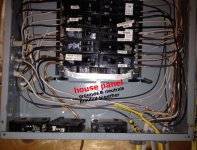Sorry DB but Mossroad's statement is correct - if you bond together a neutral and a ground in a subpanel, then the ground wire will carry some portion of the unbalanced return to the main panel - i.e. which is 100% of the return of a solo 110v leg, or some fraction of a 3-wire 220V run such as a typical modern dryer or stove/range. The current will divide itself between the neutral and ground based on the relative resistance of both routes. The lower resistance route will caryy more current, but the old saying of "path of least resistance" is not really quite true. Path of least resistance carries more current, not all of it, unless the resistance difference is extremely dramatic.
When the ground is energized, then all equipment grounds are energized, which means the cabinet to your table saw, drill press, refrigerator etc is now hot to some degree. Touch that while standing in a puddle, and you could feel it bigtime, depending on conditions.
Not all code rules are as clear cut as this one. This one is truly dangerous. A lot of the newest rules seem more like trying to remove that last 0.0001% risk, but this one is a biggie.

